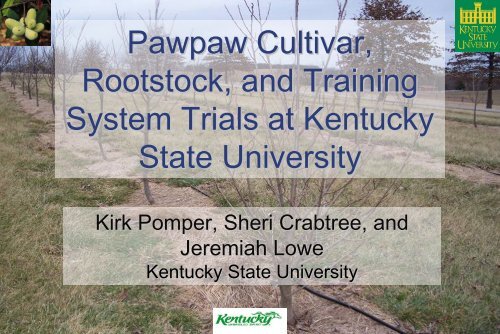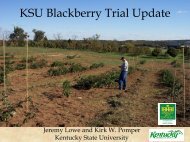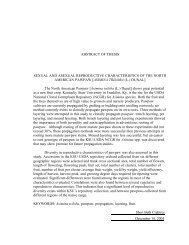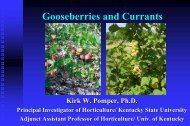Pawpaw Cultivar, Rootstock, and Training System Trials at Kentucky ...
Pawpaw Cultivar, Rootstock, and Training System Trials at Kentucky ...
Pawpaw Cultivar, Rootstock, and Training System Trials at Kentucky ...
- No tags were found...
Create successful ePaper yourself
Turn your PDF publications into a flip-book with our unique Google optimized e-Paper software.
<strong>Pawpaw</strong> <strong>Cultivar</strong>,<br />
<strong>Rootstock</strong>, <strong>and</strong> <strong>Training</strong><br />
<strong>System</strong> <strong>Trials</strong> <strong>at</strong> <strong>Kentucky</strong><br />
St<strong>at</strong>e University<br />
Kirk Pomper, Sheri Crabtree, <strong>and</strong><br />
Jeremiah Lowe<br />
<strong>Kentucky</strong> St<strong>at</strong>e University
Introduction:<br />
Wh<strong>at</strong> is <strong>Pawpaw</strong>?<br />
• <strong>Pawpaw</strong>: Asimina triloba<br />
(L.) Dunal.<br />
• N<strong>at</strong>ive tree fruit in the<br />
southeastern U.S.<br />
• Tropical-like flavor<br />
• mixture of banana,<br />
mango, <strong>and</strong> pineapple.<br />
• Early stages of<br />
commercial production.
<strong>Pawpaw</strong> Flowering <strong>and</strong> Harvest<br />
• Flower on 1 year old wood<br />
• Cross-pollin<strong>at</strong>e<br />
• Pollin<strong>at</strong>ed by flies <strong>and</strong><br />
beetles<br />
• Ripe fruit should yield when<br />
squeezed <strong>and</strong> give way with<br />
a gentle tug<br />
• Color change not a reliable<br />
indic<strong>at</strong>or of ripeness<br />
• Fruit may be harvested from<br />
the same tree over several<br />
weeks
<strong>Pawpaw</strong> Pests<br />
• Organic production<br />
possible?<br />
• Some Past Problems<br />
• Japanese beetles<br />
• Zebra swallowtail<br />
butterfly-not<br />
necessarily a pest<br />
• Talponia<br />
plummeriana -<br />
pawpaw peduncle<br />
borer
New <strong>Pawpaw</strong><br />
Diseases <strong>and</strong> Pests?<br />
• Leaf <strong>and</strong> fruit spot<br />
(Phyllosticta)
New <strong>Pawpaw</strong> Diseases <strong>and</strong><br />
Pests?<br />
Asian Ambrosia Beetle Xylos<strong>and</strong>rus crassiusculus
The <strong>Kentucky</strong> St<strong>at</strong>e University<br />
<strong>Pawpaw</strong> Research Program<br />
• Program Leaders: Brett<br />
Callaway (1990-1993),<br />
Desmond Layne (1994-<br />
1997), <strong>and</strong> Kirk Pomper<br />
(1998-Present)<br />
• USDA N<strong>at</strong>ional Clonal<br />
Germplasm Repository<br />
for <strong>Pawpaw</strong> (1994)<br />
• The orchards <strong>at</strong> KSU<br />
contain more than 2000<br />
accessions sampled from<br />
n<strong>at</strong>ive st<strong>and</strong>s from 17<br />
different st<strong>at</strong>es in the<br />
papaw's n<strong>at</strong>ive range.<br />
Pomper et al., 2003. J. Amer. Soc. Hort. Sci. 128:521-525.
<strong>Pawpaw</strong> Regional Variety Trial
Collections<br />
• Neal Peterson <strong>and</strong> Dr. Harry Swartz<br />
began collecting pawpaw germplasm in<br />
1981<br />
• They assembled a germplasm collection<br />
of about 1500 accessions<br />
• Open pollin<strong>at</strong>ed seedlings from the historic<br />
collections of Buckman, Zimmerman,<br />
Hershey, Allard, the Bl<strong>and</strong>y Experimental<br />
Farm, Ray Schlaanstine, <strong>and</strong> some modern<br />
cultivars
Some Desirable <strong>Pawpaw</strong><br />
Tree characteristics<br />
• Small tree size, easier harvest<br />
• Precocious bearing, 4 years or less<br />
• Vigorous growth with low to medium inputs<br />
• Open branching with strong crotch angles<br />
• High flower density<br />
• High fruit set under n<strong>at</strong>ural pollin<strong>at</strong>ion<br />
• Consistently high fruit yields<br />
• Cold hardiness <strong>and</strong> drought tolerance
Some Desirable <strong>Pawpaw</strong> Fruit<br />
Characteristics<br />
FRUITFULNESS<br />
over 40 fruit per tree<br />
FLAVOR<br />
sweet, firm texture, delic<strong>at</strong>e<br />
blend of flavors, rich but not<br />
cloying, no bitter aftertaste<br />
FLESHINESS<br />
visually: mostly flesh. By<br />
weight: less than 5% of the<br />
fruit is seed<br />
FRUIT SIZE<br />
over 10 ounces<br />
SEEDS<br />
over 45 seeds per oz., av. seeds<br />
as small as 3/4" (2 cm) long<br />
APPEARANCE<br />
bright clear colors, no brown<br />
mottling (ripe); even, symmetrical<br />
PECULIARITIES<br />
SKIN: waxy/ fuzzy/ thick <strong>and</strong><br />
hard/ yellow/ bluish.<br />
FLESH (ripe): white/ pink/ red.<br />
SEEDS: in a single row.<br />
RIPENING TIME: early / l<strong>at</strong>e<br />
KEEPING ABILITY: 2+ in refrig.
M<strong>at</strong>erials <strong>and</strong> methods<br />
• 28 selections, 10 named<br />
varieties, 224 total<br />
grafted trees on PPF<br />
seedling rootstock (halfsib<br />
seed)<br />
• Spacing 2 m (6.5 ft)<br />
between trees, 5.5 m (18<br />
ft) between rows<br />
• Princeton, KY (1995)<br />
<strong>and</strong> Frankfort, KY (1998)
Commercially<br />
Available <strong>Cultivar</strong>s<br />
Clone<br />
‘Middletown’<br />
‘Mitchell’<br />
‘NC-1’<br />
‘Overleese’<br />
‘PA-Golden’<br />
‘Sunflower’<br />
‘Taylor’<br />
‘Taytwo’<br />
‘Wells’<br />
‘Wilson’<br />
Genetic background<br />
Wild seedling from Middletown, Ohio<br />
Wild seedling from Iuka, Ill.<br />
‘Davis’ female × ‘Overleese’ male<br />
Cultiv<strong>at</strong>ed (open-pollin<strong>at</strong>ed) seedling from<br />
Rushville, Ind.<br />
Second-gener<strong>at</strong>ion seedling from G.A.<br />
Zimmerman collection<br />
Wild seedling from Chanute, Kans.<br />
Wild seedling from E<strong>at</strong>on Rapids, Mich.<br />
Wild seedling from E<strong>at</strong>on Rapids, Mich.<br />
Cultiv<strong>at</strong>ed (open-pollin<strong>at</strong>ed) seedlings<br />
from Salem, Ind.<br />
Wild seedling from Cumberl<strong>and</strong>, Ky.
Seedlings of<br />
Commercially<br />
Available <strong>Cultivar</strong>s<br />
Clone<br />
Genetic background<br />
1-7-1 Shen<strong>and</strong>oah Open-pollin<strong>at</strong>ed seedling of ‘Overleese’<br />
1-23 Open-pollin<strong>at</strong>ed seedling of ‘Taylor’<br />
1-68 Open-pollin<strong>at</strong>ed seedling from ‘Overleese’<br />
8-20 Open-pollin<strong>at</strong>ed seedlings of ‘Sunflower’
Seedlings from Collections<br />
Openpollin<strong>at</strong>ed<br />
Clone<br />
seedling of<br />
1-7-2 Wabash BEF-30<br />
2-10 BEF-30<br />
2-54 GAZ-VA<br />
3-11 BEF-33<br />
3-21 BEF-43<br />
4-2 Potomac BEF-53<br />
5-5 BEF-54<br />
7-90 RS-2<br />
8-58 Rappahannock BEF-30<br />
9-47 BEF-49<br />
9-58 BEF-50<br />
10-35 BEF-49<br />
11-5 Susquehanna BEF-53<br />
11-13 BEF-53<br />
BEF = Bl<strong>and</strong>y Experimental<br />
Farm Collection, Boyce Va.<br />
GAZ = George A. Zimmerman<br />
Collection., Linglestown, Pa.<br />
RS = Ray Schlaanstine<br />
Collection, West Chester, Pa.
Fruit Production on<br />
M<strong>at</strong>ure Trees 2004-2006<br />
in Frankfort<br />
Average<br />
fruit<br />
weight (g)<br />
Average<br />
number<br />
of fruit<br />
per tree<br />
Clone<br />
Potomac 235 a 44 ghi<br />
5-5 188 b 39 hi<br />
Wabash 185 b 65 fg<br />
Susquehanna 184 b 39 i<br />
NC-1 179 bc 44 ghi<br />
Overleese 170 bcd 54 fghi<br />
8-20 170 bcd 59 fghi<br />
1-68 167 bcd 90 cde<br />
2-10 160 cde 52 fghi<br />
Shen<strong>and</strong>oah 156 def 78 def<br />
Sunflower 155 def 74 def<br />
9-58 146 efg 79 def<br />
10-35 145 efg 105 abc
Fruit Production on M<strong>at</strong>ure<br />
Trees 2004-2006 in<br />
Frankfort<br />
Clone<br />
Average<br />
fruit<br />
weight (g)<br />
number<br />
of fruit<br />
per tree<br />
3-11 137 efgh 68 ef<br />
7-90 135 fghi 74 def<br />
1-23 126 ghij 90 cde<br />
11-13 124 hij 75 def<br />
Taytwo 121 hijk 73 def<br />
2-54 121 hijk 73 def<br />
3-21 115 ijkl 60 fghi<br />
Mitchell 112 jkl 58 fghi<br />
PA-Golden 108 jklm 118 ab<br />
Taylor 106 jklm 68 efg<br />
Wells 104 klm 64 fgh<br />
9-47 100 lm 74 def<br />
Rappahannock 96 lm 96 bcd<br />
Wilson 89 mn 128 a<br />
Middletown 75 n 74 def
Wh<strong>at</strong> cultivars should I plant?
NC-1<br />
• Fruit weight: 167 g<br />
• Number of<br />
fruit/tree: 36<br />
• Good flavor<br />
• Available from<br />
many commercial<br />
nurseries
Overleese<br />
• Fruit weight: 157 g<br />
• Number of<br />
fruit/tree: 40<br />
• Good flavor<br />
• (melon)<br />
• Available from<br />
many commercial<br />
nurseries
Sunflower<br />
• Fruit weight: 165 g<br />
• Number of<br />
fruit/tree: 63<br />
• Mild flavor<br />
• Available from<br />
many commercial<br />
nurseries
Potomac<br />
• Fruit weight: 244 g<br />
• Number of<br />
fruit/tree: 31<br />
• Good flavor<br />
• Fruit cracking?<br />
• Peterson <strong>Pawpaw</strong>s<br />
• Limited availability
Shen<strong>and</strong>oah<br />
• Fruit weight:<br />
157 g<br />
• Number of<br />
fruit/tree: 61<br />
• Mild flavor<br />
• Peterson<br />
<strong>Pawpaw</strong>s<br />
• Limited<br />
availability
Wabash<br />
• Fruit weight:<br />
183 g<br />
• Number of<br />
fruit/tree: 51<br />
• Dark flesh<br />
• Cracking<br />
issues<br />
• Peterson<br />
<strong>Pawpaw</strong>s<br />
• Limited<br />
availability
<strong>Pawpaw</strong> RVT Overview<br />
• There is gre<strong>at</strong> vari<strong>at</strong>ion in fruit size, yield, <strong>and</strong><br />
quality among the pawpaw selections examined<br />
• About 4 to 5 years to come into production<br />
• A number of pawpaw selections in the trial show<br />
promise for production in <strong>Kentucky</strong> [Potomac,<br />
Wabash, Overleese, Shen<strong>and</strong>oah, NC-1, <strong>and</strong><br />
Sunflower] can be recommended.
<strong>Rootstock</strong> <strong>and</strong> <strong>Training</strong><br />
<strong>System</strong> Trial
<strong>Pawpaw</strong> Propag<strong>at</strong>ion <strong>and</strong><br />
the Nursery Industry<br />
• High tree prices are limiting<br />
development of an industry<br />
• Seedlings $5-$10<br />
• Grafted trees $15-$30<br />
• Our goal is to identify seedling<br />
rootstocks th<strong>at</strong> would enhance pawpaw<br />
scion growth, improve tree<br />
establishment, <strong>and</strong> promote precocity.
<strong>Pawpaw</strong> <strong>Training</strong> <strong>and</strong> Pruning<br />
• Tend to form narrow-angled weak branches <strong>at</strong><br />
the trunk.<br />
• Therefore, pawpaws are prone to wind damage.<br />
• A central leader training system would develop a<br />
strong framework <strong>and</strong> a desirable form for<br />
harvesting.<br />
• Will pruning dwarf a young tree <strong>and</strong> delay bearing in<br />
pawpaw?<br />
• Will fruit suffer sunburn?
Objective<br />
• To determine if cultivar,<br />
rootstock, <strong>and</strong> training<br />
method would influence<br />
early flower bud<br />
production in pawpaw
M<strong>at</strong>erials <strong>and</strong> Methods<br />
• The rootstock trial was planted<br />
on May 10, 2004.<br />
• <strong>Rootstock</strong>s: 5 seedling<br />
rootstocks<br />
• Scions: ‘Sunflower’ <strong>and</strong><br />
‘Susquehanna’<br />
• Two pruning systems: minimal<br />
pruning versus central leader<br />
• 8 replic<strong>at</strong>e blocks with each<br />
tre<strong>at</strong>ment combin<strong>at</strong>ion for a<br />
total of 160 trees (2 x 5 x 2 x<br />
8= 160).
Why Did We Choose These<br />
Selections?<br />
• Scions:<br />
• ‘Sunflower’<br />
• Noted to flower <strong>and</strong> produce fruit in 4 th year in Princeton, KY trial.<br />
• ‘Susquehanna’<br />
• Slow to flower <strong>and</strong> to come into production.<br />
• Seedling rootstocks:<br />
• <strong>Cultivar</strong>s vigorous: Sunflower <strong>and</strong> PA-Golden<br />
• <strong>Cultivar</strong>s lack vigor: Susquehanna <strong>and</strong> K8-2<br />
• Commercial mixed seed: RVT<br />
• Studies with seedlings in containers<br />
• Seed size <strong>and</strong> genetic background important
End of 2004<br />
9/21/04
End of 2005<br />
3/03/06
End of 2006
End of 2007<br />
1/28/08
3/23/07<br />
Central leader<br />
Minimal pruning
1/28/08<br />
Central leader<br />
Minimal pruning
8/31/08
8/31/08
2008 Growing Season<br />
Scion<br />
Percent of Trees<br />
Flowering Survival TCA Flower Density<br />
Number of<br />
Clusters<br />
Susquehanna 94% 68% 14.3 1.6 3.7<br />
Sunflower 100% 82% 14.3 6.0 7.0<br />
P-value 0.04 * 0.06 NS 0.64 NS 0.0000*** 0.011 *<br />
<strong>Rootstock</strong><br />
Percent of Trees<br />
Flowering Survival TCA Flower Density<br />
Number of<br />
Clusters<br />
RVT 96% 77% a 13.8 3.8 4.1<br />
Sunflower 96% 90% a 14.0 4.2 5.6<br />
PA-Golden 100% 84% a 15.7 4.1 6.3<br />
K8-2 95% 73% a 14.0 3.5 3.4<br />
Susquehanna 100% 52% b 13.7 4.7 7.1<br />
P-value 0.63 NS 0.005 ** 0.32 NS 0.13 NS 0.2041 ns
2008 Growing Season<br />
<strong>Training</strong><br />
Method<br />
Percent of Trees<br />
Flowering Survival TCA<br />
Flower Buds<br />
Per Tree<br />
Number of<br />
Clusters<br />
Number of<br />
Fruit<br />
Minimal Pruning 98% 72% 17.4 63 6.8 14.7<br />
Central Leader 97% 79% 11.5 50 4.4 9.3<br />
P-value 0.63 NS 0.20 NS 0.0000*** 0.015 * 0.0093 ** 0.003 **<br />
• No evidence of sun scald on fruit
<strong>Rootstock</strong> <strong>and</strong> <strong>Training</strong> <strong>System</strong><br />
Conclusions<br />
• Genetic background of seedling rootstock<br />
did not influence scion precocity or growth.<br />
• Survival of Susquehanna seedling rootstock<br />
was poor.<br />
• Sunflower was more precocious than<br />
Susquehanna.<br />
• Central leader training tended to reduce<br />
vigor (TCA) <strong>and</strong> the number of flowers/tree.
• Over 200,000 visitors since 2003!
Questions?








